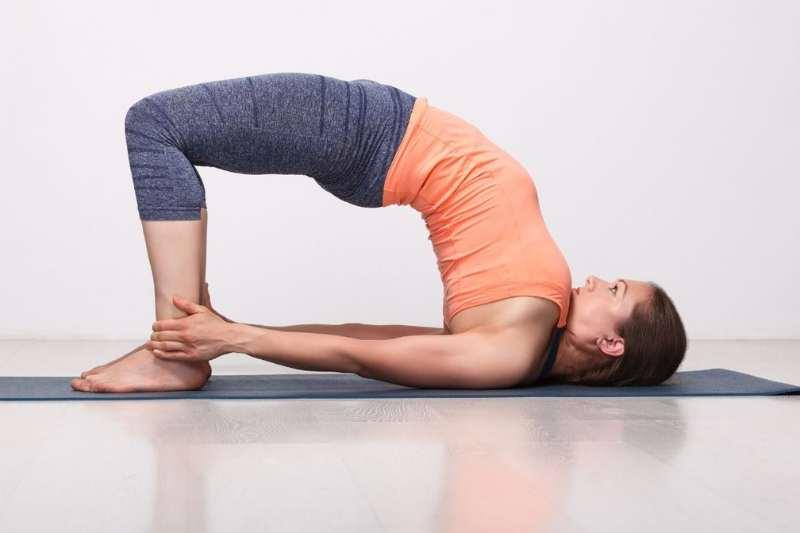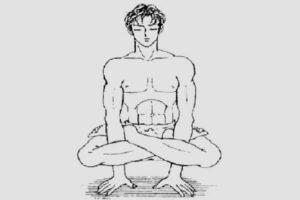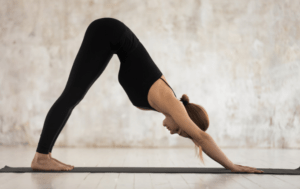Kandharasana, commonly known as Shoulder Pose, is a revered yoga asana that has numerous mental and physical advantages. This strong position opens the chest, strengthens the shoulders, and imparts a sense of solidity and foundation. In this essay, we will go further into the practise of Kandharasana, examining its components, highlighting its many advantages, and talking about key safety measures. This thorough instruction will assist you in mastering Kandharasana and reaping its benefits whether you are an experienced yogi or a newbie.
Understanding Kandharasana (Shoulder Pose)
Kandharasana, which means “shoulder pose,” is a potent yoga posture that works the shoulders, back, and chest muscles. It is derived from the Sanskrit words “kandha,” which means “shoulder,” and “asana,” which means “pose.” It is a version of Setu Bandhasana (Bridge position), and because it gives the shoulders a greater stretch, it is a great position for increasing this area’s strength and flexibility.
Steps to Perform Kandharasana (Shoulder Pose)
Put on Kandharasana by following these detailed instructions:
On a cosy yoga mat, lie flat on your back.
Put your feet firmly on the ground hip-distance apart while bending your knees.
Keep your arms by your side, palms downward.
Take a big breath in and firmly plant your feet and palms on the ground.
Slowly raise your hips off the mat as you exhale, letting your chest rise in the process.
Put your fingers together and slide your shoulders under your body.
Straighten your arms while extending them while pressing your hands together.
Open up your chest by gently rolling your shoulders back and down.
Hold the position while inhaling deeply for 30 to 60 seconds.
Exhale to release, then slowly bring your shoulders and hips back to the mat.
Pro Tip: Keep your breath steady and tighten your abdominal muscles throughout the position.
Benefits of Kandharasana (Shoulder Pose)
There are numerous advantages to Kandharasana for the body and psyche. The following are some major advantages of performing Kandharasana:
Strengthened Shoulders: Shoulder Pose focuses the deltoids and trapezius, two shoulder muscles. By regularly performing this pose, you may develop and tone these muscles, which will improve your posture and upper body stability.
Expanded Chest: Kandharasana promotes the expansion of the ribcage by allowing the shoulders to slide beneath the body and opening up the chest. This intense stretch increases lung capacity, improves breathing techniques, and fosters openness and self-assurance.
Increased Spinal Flexibility: In Kandharasana, the spine gently bends back as you lift your hips and roll your shoulders back. By increasing the spine’s flexibility and mobility, this action helps to release tension and encourage a healthy range of motion.
Relaxed Shoulders and Neck: The tension and discomfort in the shoulders and neck are frequently caused by modern lifestyles. By releasing and stretching the muscles in these places, Kandharasana aids in reducing this tension. Pain in the neck and shoulders might be lessened with regular practise.
Heart Chakra Stimulated: Kandharasana’s chest opening activates the heart chakra, also known as Anahata. Love, compassion, and emotional health can all be strengthened by this energising influence.
Reduced tension and Anxiety: Kandharasana is a yoga pose that, like many others, encourages relaxation and reduces tension. This pose helps to relax the mind, lessen anxiety, and foster mental clarity because it requires deep breathing and concentration.
Better Digestion: Kandharasana’s gentle compression of the abdomen soothes the digestive system, improving digestion and easing discomfort. The digestive system can become healthier with regular practise.
More conscious connection between the body and the breath is necessary for Kandharasana, which increases body awareness. By developing body awareness and mindfulness, you’ll be better able to recognise and attend to the requirements of your physical and mental well-being.
Balanced Energy Flow: Kandharasana practise, according to yogic philosophy, aids in balancing the body’s energy flow. The Vishuddha (throat) and Anahata (heart) chakras are thought to be activated, providing harmony and balance in these energy centres.
Increased Confidence: Kandharasana opens up the chest and promotes an upright posture, which can improve body image and increase self-confidence. This position creates a feeling of empowerment and inner strength.
Keep in mind that Kandharasana has advantages that go beyond the physical world. Your yoga journey can experience a significant transformation of the body and mind with consistent practise, bringing harmony and balance.
Precautions to Consider
Although Kandharasana has several advantages, it is important to practise it carefully and take the following safety precautions:
Observe your body: Do not force yourself into the pose; rather, respect the limitations of your body. As soon as you feel any pain or discomfort, ease out of the stance.
Warm-up: To prepare your shoulders, back, and hips for Shoulder Pose Yoga, warm up your body with easy stretches and motions.
Avoid if injured: It is best to avoid Kandharasana if you have any shoulder, neck, or back issues, or to perform it under the supervision of a certified yoga instructor.
Modify as necessary: To get a secure grip if you find it difficult to interlace your fingers beneath your body, you can use a strap or hold onto the edges of your mat.
Before performing Kandharasana or beginning any new workout programme, it is always advised to speak with a healthcare practitioner if you have any medical ailments or concerns.
Pregnancy: Kandharasana should be avoided by expectant mothers. To guarantee a secure practise while pregnant, it is advised to get advice from a prenatal yoga expert.
You can experience Kandharasana’s transforming effects while protecting yourself from potential injury by performing it carefully and with these safety measures in mind.
FAQs about Kandharasana (Shoulder Pose)
1. Is Kandharasana suitable for beginners?
Absolutely! Beginners can perform Kandharasana, although it is advised to start with modifications and progress towards the full expression of the position over time. Follow your body’s cues and move forward at a speed that is comfortable for you.
2. Can Shoulder Pose alleviate shoulder pain?
Yes, consistent practice of Shoulder Pose, which stretches and strengthens the muscles surrounding the shoulders, can assist relieve shoulder pain. However, it is advised to speak with a healthcare provider before attempting the pose if you have a specific shoulder injury or ailment.
3. How long should I hold Kandharasana?
Kandharasana should ideally be held for 30 to 60 seconds. Keep your breath steady and comfortable throughout the pose by remembering to breathe deeply.
4. Can pregnant women practice Kandharasana?
Kandharasana should be approached with caution by expectant women. For advice on how to adjust the posture for a particular person’s pregnancy stage and needs, it is important to speak with a prenatal yoga specialist or seek direction from a certified yoga instructor.
5. Are there any variations of Shoulder Pose?
Yes, there are different Shoulder Pose versions with varying degrees of benefit and intensity. One version involves supporting the backbend with a yoga block or bolster placed beneath the sacrum. To engage the core and give an additional challenge, one additional variation is to elevate one leg at a time while holding the stance.
6. Is it necessary to warm up before practicing Kandharasana?
Yes, warming up your body is essential before performing Kandharasana. Warm up the shoulders, back, and hips by doing gentle stretches and exercises. This lowers the possibility of damage and helps your body get ready for the deeper stretch.
Conclusion
The shoulder pose, or kandharasana, has several health advantages for the body, mind, and spirit. You may strengthen your shoulders, open up your chest, and feel a strong sense of solidity and stability by performing this posture with perfect alignment, mindfulness, and respect for your body’s boundaries. Always pay attention to your body, adjust the position as necessary, and ask for advice from a certified instructor if you have any questions or medical conditions. Accept the transforming power of Kandharasana and set off on a journey of wellness and self-discovery.
Yoga in India – 200 Hour Yoga Teacher Training in Rishikesh – Aerial Yoga in Rishikesh – Kundalini Yoga in Rishikesh – Ashtanga Yoga in Rishikesh – Ayurveda Yoga in Rishikesh




